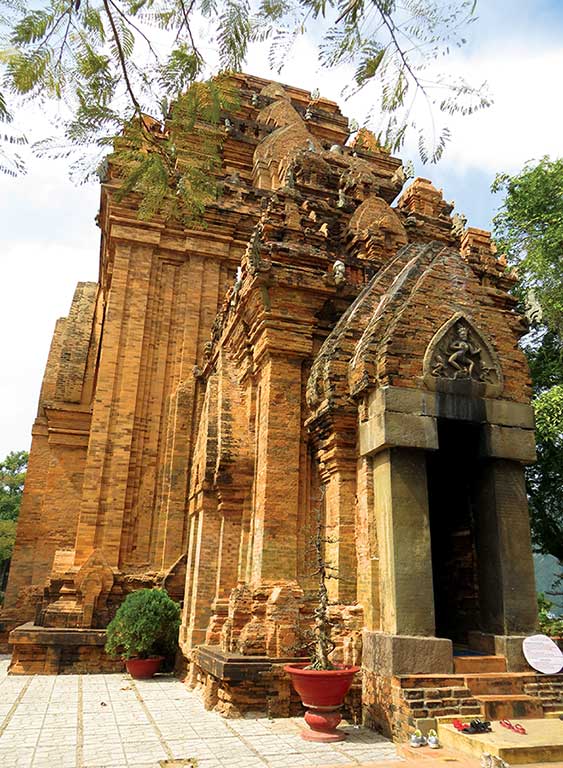There are two notable sights north of Nha Trang: the Po Nagar Towers and Hon Chong, both excellent sites for scenic views and interesting histories. Both are easily visited in one trip, stopping first at the towers and then continuing along the same road for another mile to the sea.
One mile north of Nha Trang, the Po Nagar Towers (2 Thang 4, 6am-6pm daily, VND21,000) bear not one but two histories. From the 8th to the 13th centuries, the Cham empire built these Hindu temples to honor Po Nagar, their most significant female deity. When the Vietnamese arrived in 1635, ending Cham authority, they adopted the towers and Po Nagar became Thien Y A Na, a young girl taken in by an elderly, childless couple who taught her people to farm rice.
One mile north of town, the Po Nagar Towers bear not one but two histories.Inside the entrance gates are 22 columns (once 24). Here, the Cham would prepare offerings before hiking up the steep steps at the far end of the clearing. The tallest of the four towers is dedicated to Po Nagar and houses a black stone statue of the deity, which dates back to AD 1050.Beside the main tower, a slightly smaller structure belongs to Shiva (in the Cham version) or Thien Y A Na’s husband (for the Vietnamese). Inside is the largest linga and yoni statue (symbols representing male and female energies) on-site.
The remaining two towers are more humble, each housing a smaller linga and yoni statue. The one beside the two large structures honors Skanda, first-born son of Shiva, as well as the adoptive parents of Thien Y A Na. Behind Po Nagar’s main tower, the smallest structure is dedicated to Ganesh, second-born son of Shiva, and the children of Thien Y A Na, Princess Quy and Prince Tri.

Po Nagar Towers. Photo © Dana Filek-Gibson.
Peek inside the exhibition room at the back, where replicas of the towers’ statues are on display. Near the steps, Po Nagar also offers nice views of the Cai River.
Many tour groups and independent travelers pass through the towers. Respectful dress is a must inside the temples. Guests can use the gray robes located near the main tower, free of charge, if they are not dressed appropriately.
Overlooking the sea, the rocky promontory of Hon Chong (Pham Van Dong, tel. 05/8628-9137, 6am-6pm daily, VND21,000) extends out from the southern end of Bai Duong Beach in a series of smooth, tan, stone formations. By the ticket booth, three traditional Vietnamese houses display local specialties and handicrafts, plus an array of musical instruments used by the region’s ethnic minorities. Musical demonstrations occur when visitors arrive in large numbers.
![Hon Chong from Co Tien beach. Photo © Vinhtantran (Own workby uploader) [<a href="http://creativecommons.org/licenses/by-sa/3.0">CC BY-SA 3.0</a>], <a href="https://commons.wikimedia.org/wiki/File%3AHon_Chong_from_Co_Tien_beach.JPG">via Wikimedia.](https://www.holidaytravel.cc/Article/UploadFiles/201602/2016021614445517.jpg)
Hon Chong from Co Tien beach. Photo © Vinhtantran (Own workby uploader) [CC BY-SA 3.0], via Wikimedia. Commons
Down a set of stairs, you’ll clamber over a jumble of sandy rocks as you head toward the sea. Passing under the formation known as Heaven’s Gate, in which a substantial rock hangs precariously between two larger stones, can be a nerve-racking experience. The formation has been this way for centuries without incident.Towering above the rest at the far end of the promontory is Hon Chong, the stone after which the place is named. Legend has it that fairies used to bathe in the waters near Hon Chong. One day, while spying upon these bathing beauties, a rather inebriated giant stumbled and nearly slipped off the rocks. The massive gouge in Hon Chong that resembles a handprint is where the giant caught himself and managed not to fall in. As you face the ocean, to your right is Hon Do, or Red Island, a small piece of land that houses a Buddhist pagoda and is so named for the color it turns at sunrise.
While it is possible to hire an English-speaking guide (VND50,000) from the ticket booth, this is not really necessary as the major draw of the place is its scenery. Most visitors simply wander around on the rocks, snap some photos, and then enjoy a coffee at the adjoining café, which overlooks Hon Chong and Bai Duong Beach.
Excerpted from the First Edition of Moon Vietnam.